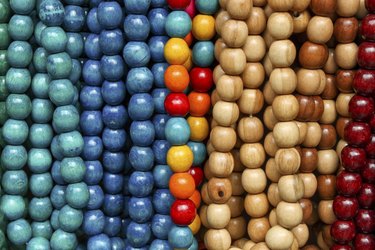
Beads have played a huge part in many African cultures both historically and in contemporary times. Archaeologists even discovered small shells strung together in a South African cave that they determined to be more than 75,000 years old! African beads have fascinating cultural significance, including representations of beauty, pride, power and identity, to the extent that bead work can be considered a complex language of its own. African beads were used historically as currency, and continue to be valuable in trade as jewelry, ornamentation and works of art.
The Significance of African Beads
Video of the Day
The significance of African beads varies by nation, region and the groups of people who create and use them. The Zulu people of South Africa, for example, developed a code for the size and colors of their beads. Large and colorful beads symbolize wealth and social status, and blue beads are thought to enhance fertility. Red beads are reserved for ceremonies like tribal festivals, funerals, circumcisions of young boys and harvest dances. When strung with black beads, a Zulu bracelet's meaning relates to age and wisdom.
Video of the Day
Beads can also convey identity and cultural significance. For example, beads on an African necklace can show if a woman is married or a man is a warrior or an elder. Beads also signify a person's rank. Because of the rainbow of colors embedded in them, Mali wedding beans signify beauty, and are given to brides on their wedding day. African beads might also be associated with Christianity and Islam, just as those religions use prayer beads in other parts of the world.
Materials Used for African Beads
African beads can be made out of a huge variety of materials, including shells, wood, bone, amber, glass, stone, clay and metals. In modern times, plastic beads are also widely available. Historically, bead-makers would use locally found natural materials including exotic woods, cowrie shells, animal teeth, bone and ivory. Egyptians in pre-Christian times created ornate beads out of faience, a type of glazed quartz, along with precious metals. African beads represent every size, style and design imaginable, from intricately carved beads to plain, tiny seed-size beads.
Uses for African Beads
African beads have for centuries been exchanged for food and livestock. Some Africans even believe beads have magical powers, such as imparting fertility. Some African women, such as the Yoruba of West Africa, wear beads around their waists to highlight their figures, for dancing, and for healing and rejuvenation purposes. In the 21st century, many African people continue to use and wear beads for cultural recognition, status and adornment.
African Bead Work Techniques
The techniques of African bead work vary by era, region and the individual artists' skills. Bead workers are people who use beads to make jewelry, clothing, decorate sculptures, and other ceremonial objects. They may place beads on fiber cord or metal wire to create their bead work, or they may stitch beads to a fiber backing. Bead work continues to be an important tradition across the continent, and contemporary artists continue to experiment with new designs and colors.
Bead makers often produce and create the beads themselves from various materials. They have provoked the attention of bead collectors and jewelry designers all over the world.